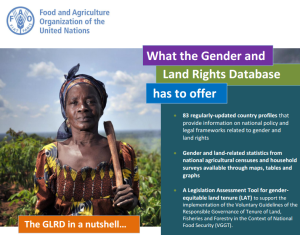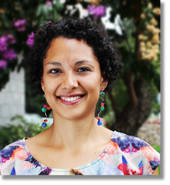For decades feminist economists and women’s rights advocates have made the case that the lack of data on women’s land rights has limited the ability to understand how this affects food security and rural poverty. However, recent developments may help us to overcome this challenge. The new SDGs have identified women’s land rights as a priority, setting them as targets in both Goal 1 (end poverty in all its forms everywhere) and Goal 5 (achieve gender equality and empower all women and girls). Numerous UN agencies – including FAO and UN Women- are supporting the use of land indicators disaggregated by sex (in addition to type of tenure, age cohorts and ethnicity) to monitor targets regarding equal rights to economic resources, including land (t 1.4) and undertaking reforms to give women equal rights to economic resources (t 5a).
The most widely used proxy to measure women’s land rights has been the “distribution of agricultural holders by sex”, made available in FAO’s Gender and Land Rights Database (GLRD). This statistic is derived directly from agricultural census data and based on the legal entity of the farm and its manager or holder. While it identifies the extent to which women have management responsibility for agricultural production resources, this statistic alone cannot capture the complex realities of women’s control over land. This statistic has four major limitations:
- While there is great potential overlap between management/holding rights and ownership rights; they may also differ, particularly in contexts where property rights are not well defined.
- Most agricultural censuses identify only one holder per agricultural holding and men are usually designated the holder of the family farm. Therefore, it may underestimate women’s role in agricultural decision-making and management.
- Some countries only include landholdings above a threshold size. Given that women’s landholdings are typically smaller than men’s, more of women’s landholdings may be excluded.
- Finally, agricultural censuses are undertaken only approximately every 10 years, given their high cost.
 This statistic, therefore, is not very practical as a monitoring tool. Motivated by the need to both monitor progress on the SDGs and operationalize landownership statistics into national statistical systems, the GLRD team partnered with the CGIAR Research Program on Policies, Institutions, and Markets (PIM) to adapt PIM’s landownership statistics framework to the requirements of global statistics (reliability, coverage, and comparability across countries). These recent developments are explained in this technical note.
This statistic, therefore, is not very practical as a monitoring tool. Motivated by the need to both monitor progress on the SDGs and operationalize landownership statistics into national statistical systems, the GLRD team partnered with the CGIAR Research Program on Policies, Institutions, and Markets (PIM) to adapt PIM’s landownership statistics framework to the requirements of global statistics (reliability, coverage, and comparability across countries). These recent developments are explained in this technical note.
A statistic on landownership rather than land management is more appropriate for measuring progress against t5a of the new SDGs; however, it has some complications of its own. The most important one is that definitions of ownership often vary across countries and surveys. “Documented ownership” means that ownership is verified through title or deed, while “reported ownership” relies on individuals’ own judgment. Reported ownership may be more appropriate in countries where a formal registration system is not in place and where customary tenure of land prevails. Additionally, where there is no private landownership, it is more appropriate to use proxies that capture individuals’ capability to control and make decisions over land. These proxies may include the right to sell, to bequeath or the right to decide how to use the land.
In the last few months, the GLRD team, in collaboration with representatives of civil society organizations and representatives of indigenous peoples’ groups, as well as with UN Women and the UN Statistics Division (UNSD), has developed the following indicators, which FAO is endorsing for the monitoring of SDG target 5a:
- Percentage of people in agricultural population with ownership or secure rights over agricultural land, by sex and type of tenure; and
- Share of women among owners or rights-bearers of agricultural land, by type of tenure
These indicators are reliable because the identification of the plot owner(s) or individual with rights over land in household surveys and the agricultural population is feasible, demonstrated by the experience of the Living Standards Measurement Study-Integrated Surveys on Agriculture (LSMS-ISA) and the Evidence and Data for Gender Equality (EDGE) projects. Also, these surveys can be done more frequently (about every 2-4 years), capturing significant changes in landownership. In terms of coverage, household sample surveys are typically statistically representative at national and subnational levels. However, in terms of comparability, there are more issues. The different definitions of ownership and rights over land across countries can be problematic. Therefore, a wide range of land rights organizations have concluded that the indicators need to include a broader conceptualization of rights, and allow certain proxies of bundles of rights over land, as long as these are clearly defined and limited to a precise list. Aggregating by type of tenure will allow more clarity on the types of arrangements or rights under which land is operated, and will also capture tenure security, one of the key concerns in the SDG discussions.
The next steps will be to strengthen the ability of statistical systems to collect information at plot level, identify the different right bearers and the type of tenure of the land over which they have rights; collect these data at least every 2-4 years; and ensure that surveys implemented enable the disaggregation of data by type of agricultural land (including land for forestry, aquaculture and livestock) as well as the identification of the agricultural population and indigenous populations.
Further reading
Gender and Land Statistics: Recent developments in FAO’s Gender and Land Rights Database
Gender inequalities in ownership and control of land in Africa: myth and reality (open access IFPRI discussion paper version available here)
Examining gender inequalities in land rights indicators in Asia (open access IFPRI discussion paper version available here)
About the author
 Ana Paula de la O Campos is an economist and policy analyst in the areas of agricultural transformations, gender, and social protection. She started her career with FAO in 2007 as an econometrician specializing in rural labour and household income strategies, contributing to the creation of the Rural Income Generating Activities database (RIGA) as well as to the design of household surveys for conducting impact evaluation of cash transfers in Sub-Saharan Africa. She is currently the strategic programme advisor for FAO’s programme on reducing rural poverty, designing and promoting integrated approaches that lead to positive impacts in food security and nutrition, women’s empowerment and rural poverty reduction. She also manages the overall functioning of the Gender and Land Rights Database (GLRD).
Ana Paula de la O Campos is an economist and policy analyst in the areas of agricultural transformations, gender, and social protection. She started her career with FAO in 2007 as an econometrician specializing in rural labour and household income strategies, contributing to the creation of the Rural Income Generating Activities database (RIGA) as well as to the design of household surveys for conducting impact evaluation of cash transfers in Sub-Saharan Africa. She is currently the strategic programme advisor for FAO’s programme on reducing rural poverty, designing and promoting integrated approaches that lead to positive impacts in food security and nutrition, women’s empowerment and rural poverty reduction. She also manages the overall functioning of the Gender and Land Rights Database (GLRD).
Featured image: Sharing Farming and Care Work, Flickr. Photo by Todd Post/Bread for the World.
This post is part of EnGendering Data, a blog on collecting and analyzing sex-disaggregated data to improve the knowledge base on the role of gender in agriculture and food security, maintained by the CGIAR Research Program on Policies, Institutions, and Markets (PIM).



